"Far from the Light of Day"


Given the codename PADDOCK, planned in 1937 and built in early 1940. The two storey underground citadel was to house the War Cabinet in the event of the Whitehall Cabinet War Room becoming uninhabitable through heavy bombing.
Located in the grounds of the GPO Research Station at Dollis Hill, north-west London.
The first Cabinet meeting at PADDOCK on 3rd October 1940 was mentioned by Winston Churchill in his memoirs.
"We held a Cabinet meeting at PADDOCK far from the light of day, and each Minister was required to inspect and satisfy himself about his sleeping and working apartments. We celebrated this occasion with a vivacious luncheon, and then returned to Whitehall."
The citadel was manned by a skeleton staff during the blitz. The second, and last, Cabinet meeting at Paddock was held on 10 March 1941, but Churchill was ill and did not attend.
In 1941 the citadel was re-allocated to other Government Departments and the War Office.
The lower floor is 40 feet below the surface. and contained 22 rooms.
The largest the Map Room with rooms for the Cabinet and PM next door.
The diesel emergency electricity generating plant is on the lower
floor.
The upper floor was slightly larger and contained the Commonwealth Telephone Exchange, the Ventilation Plant with Air Scrubbers and the kitchens.
Built to withstand the impact of a 250 Kg GP bomb
Strangely there are no lavatories within the citadel, the nearest would have been in the surface buildings, now demolished.
Built on marshy ground and two pumps needed to prevent flooding. Possibly the recent flooding is due to the foundations being disturbed by the nearby building works. Today the bottom floor is flooded to a depth of 18 inches (0.46m). But pumps are installed to pump out any seepage.
The Main Corridor is about 120 feet long and halfway along is the main stone staircase to the surface and to both levels.
Our entrance was by narrow iron staircase at the end of the corridor and would have been the emergency exit. At the end of the corridor is another iron staircase, the exit to the surface is sealed but the staircase to the lower floor is intact.
THE ENTRANCE

Our Entrance. One of the Emergency Exits
THE UPPER FLOOR

The wire cage
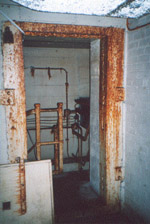
The other Emergency Stair case to the lower floor.
Gas tight door removed for safety and laying on it's side.

"Essential" and "Non-essential" fuze box
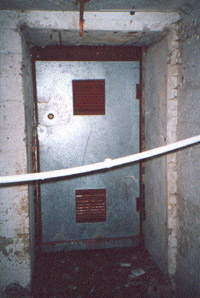
The inside view of the door at the top of the main stairs. Through
the surface building, this would have been the main entrance to the citadel

GPO Main Distribution Frame, rack with cable supports to the right
The most important function of the bunker was to provide secure communication
with other Government and Military departments.
THE MAIN STAIRCASE
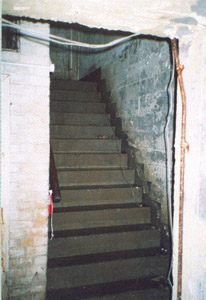
Main stair case, view from upper floor to landing before surface.
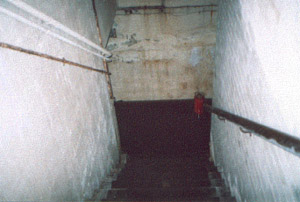
Main stair case, view down to lower floor.
THE LOWER FLOOR

"Floor 27", the lower floor.
These signs date from the post war use of the building. It was GPO
procedure to denote areas within the complex with floor spaces by
number. Not to be confused with storeys.
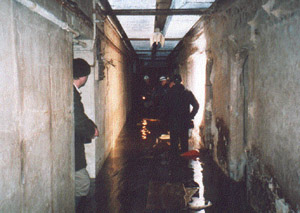
Main corridor.

Tangye Diesel Engine Emergency Generator.
24 volt electric or hand cranked start.